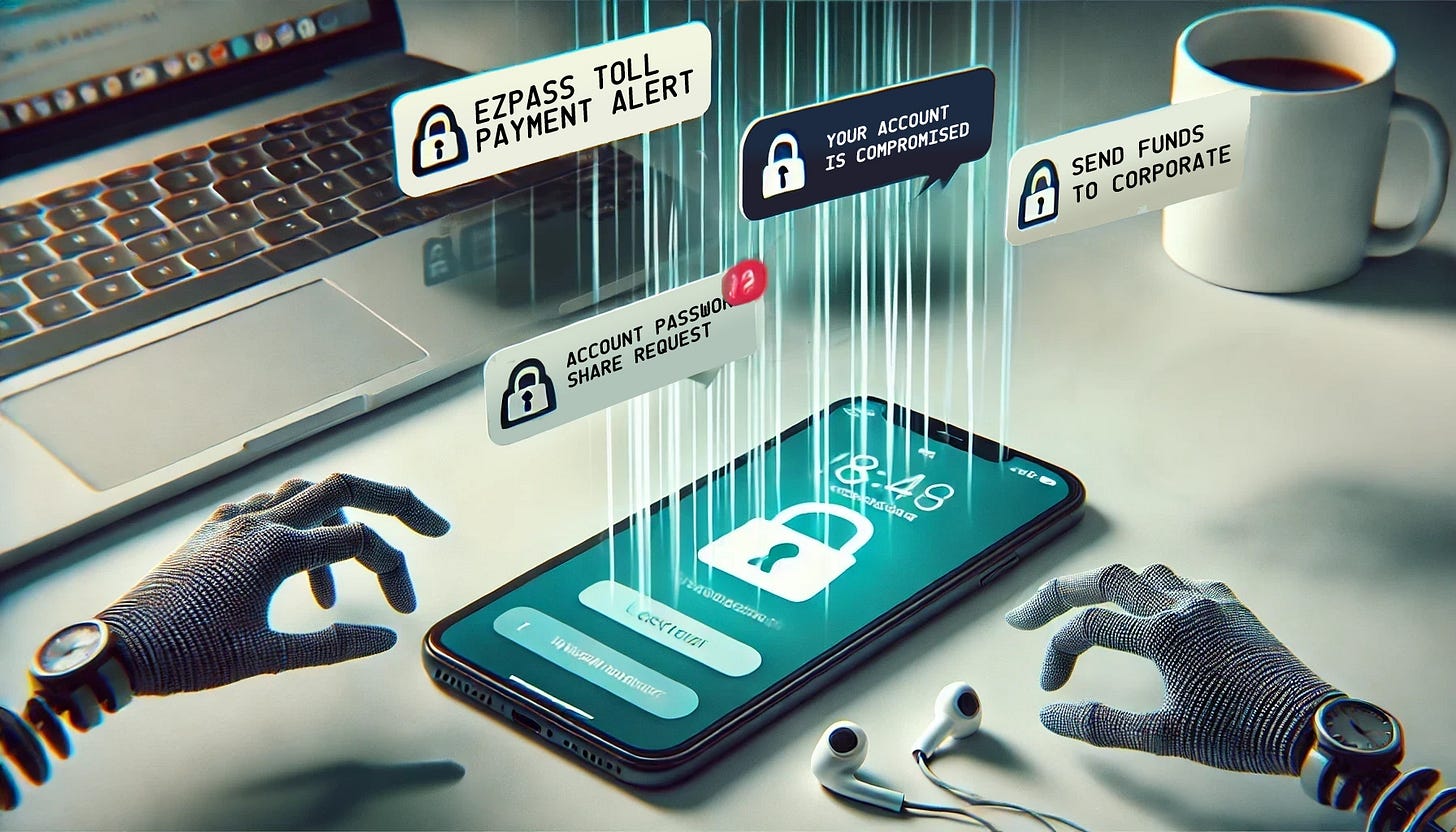PPPPatterns Emerging (Four Ps #257)
Navigating Hype, Hesitation & Hidden Signals in the Messages
Some weeks feel like they should come with a warning label.
High risk! Loud noise! Handle with curiosity!
It’s easy to play it safe.
To dismiss, delete, or defer.
To choose certainty over complexity.
But growth doesn’t happen in an echo chamber.
And clarity doesn’t come from volume. It comes from pattern recognition.
From asking better questions. From looking under the hood.
There’s a fine line between hype and hope.
Between instinct and insight.
Between being cautious… and being closed-minded.
Let’s see what surfaces.
THE PROFESSIONAL: A.I.dentity Crisis
AI Agents: A phrase that means everything and nothing at the same time.
Lately, it’s become one of those overused buzzwords that everyone is tossing around without a shared definition.
Like “synergy” in the early 2000s.
Or “blockchain” five years ago.
It's resulting in a lot of confusion. And, let’s be honest, a fair amount of bullshit.
The reality is, AI Agents have been around for years. They’re not some futuristic, all-powerful overlords. In fact, you’ve already interacted with dozens today, whether you realize it or not.
🛒 The algorithm suggesting what to buy next? AI Agent.
📧 The spam filter saving your inbox from destruction? AI Agent.
📅 The assistant that schedules your meetings without you lifting a finger? AI Agent.
So if AI Agents have been quietly running in the background, why are we suddenly acting like they’re new? And why can’t anyone agree on what they actually are?
Some people think AI Agents are self-sufficient entities that can make decisions and take actions on their own.
Others see them as glorified chatbots with fancy automation scripts.
Some companies define them as digital workers, while others use the term for personal assistants that fetch data, summarize content, or book flights.
And the more we talk about AI Agents without aligning on what we mean, the more we’re confusing each other.
For those of us actually building and marketing them (🙋♂️), this is the challenge. At Genuin, we’ve introduced AI-powered agents over the past few months, and as a marketer, I’m constantly straddling the line between explaining what they do and getting lost in the tech itself.
Even if the tech is pretty f*cking cool.
So my approach: Don’t just market AI Agents, Market the System.
In a nadir or noise at the bottom of a sea of sameness, this is the real opportunity: AI Agents shouldn’t be marketed as standalone products. You also don’t need to build them yourselves. Because partnering is a better bet for most companies at the moment.
Yet the biggest mistake companies are making right now is positioning AI Agents as “the thing” rather than part of the system. AI, at its core, is an infrastructure play. It’s the foundation that powers everything from workflow automation to customer engagement to community building.
This is where a lot of AI companies are getting it wrong. They’re hyping up agents without explaining how they fit into the bigger picture. Consumers don’t just want an agent—they want a solution that works. They want an ecosystem that’s intelligent, seamless, and built into the experiences they already use.
That’s the difference between selling a product and selling a platform.
And at such a monumental inflection point for tech, creative, and marketing, we have to get this right. Our job isn’t just to make AI sound exciting (it already is).
It’s to position it in a way that makes sense to real people. We need to move beyond hyping up AI Agents as individual superheroes and focus on the larger narrative.
What problem are we solving? What’s the actual impact? How does this connect to a broader strategy?
AI Agents are a piece of the puzzle, but they’re not the whole picture. And they still make many of mistakes. The companies that understand this will win. The ones that keep selling “agents” as a magic fix-all? They’re in for a rude awakening.
Let’s sell the story. Not just the sizzle.
THE PRACTICAL: Phishing Trip
Another cybersecurity training? Yes. But there can never be too many at this point.
As part of my company’s SOC2 compliance requirements, all employees were required to complete an online phishing and scam training program last week.
Watch a few videos, answer a few questions, prove that I know how to spot a fake email. Easy enough.
Except, apparently, not for everyone.
Because phishing scams are still wildly successful. And not just on our parents (who still believe their “Apple support” pop-ups). Digital natives — the people who grew up online — are actually more likely to fall for phishing scams than older generations.
Wait, what? 🤔
If you came of age during Web 1.0, you remember the Nigerian prince emails. A royal fortune, locked away, just waiting for your bank details. It was so ridiculous it became a joke.
But phishing has evolved. Now it’s:
✅ A DM on Instagram inviting you to an exclusive event.
✅ An email saying your Netflix subscription is on hold.
✅ A text from “EZPass” claiming you owe an unpaid toll.
And our younger adults are falling for it in droves.
A recent study found that 82.9% of Instagram users aged 16-29 clicked on at least one phishing link. Apparently because of FOMO. Scammers know that an invite to a private party or a chance to win a giveaway triggers an impulse: click first, think later.
The latest one I ignored, but apparently many have not... toll road phishing.
Over the past few months, fake toll payment texts have exploded across the U.S. These messages claim you owe money to EZPass, FastTrak, PeachPass, or some other state toll system, threatening fines or license suspensions if you don’t pay up.
Sounds scary. But:
👉 The real toll systems do not send payment requests via text. 👉 Scammers use realistic-looking logos and URLs to trick people. 👉 They only need a handful of victims to make the whole operation profitable.
Researchers have tracked 60K+ fake toll scam domains, many of them tied to Chinese cybercrime gangs. Some have even built scam call centers in the jungle (seriously, it’s a thing).
And it works. Even though a text for a $3 toll fee might seem harmless, it’s not about the money—it’s about stealing your credit card info.
So why aren't we more paranoid? (A question I ask myself everyday!) At this point, we should all have some baseline rules:
🚫 Don’t trust anyone.
🔍 Verify everything.
📩 Don’t click. Ever.
But we don’t. We still fall for scams, still take the bait, still let urgency override common sense. Even when we know better.
And it’s only getting worse. AI is making phishing scams more believable. Scammers are adapting. And as long as people keep clicking, they’ll keep phishing.
My advice (basically rehashed from memory from the phishing scam training):
If you weren’t expecting it, be skeptical. Unsolicited messages? Assume they’re fake.
Check the sender. Government agencies, banks, and toll systems don’t text you for payments.
Never click links in emails or texts. Go to the official website directly.
Don’t engage. Even replying “stop” tells scammers your number is real.
Slow down. Scammers thrive on urgency. Take a breath before you react.
And when in doubt, use "The Old Lady Test." 👵 One of my favorite stories from the recent toll scam fiascowas a 77-year-old woman in Ohio got the fake toll text and immediately deleted it.
"I don’t drive and haven’t for over 30 years," she said
Let’s all channel that level of skepticism. And if you ever feel the need to double-check something? Good. That hesitation is your best defense.
Stay safe. And thanks for clicking on all of these links... 😉
THE PERSONAL: Pessimism or Pragmatism?
Have I become a curmudgeon? A naysayer?
Or am I just a pragmatic realist with a little less patience than I used to have?
It’s been creeping in quietly. At work, at home, even in conversation. Someone shares an idea or a plan and my brain instantly runs a diagnostic scan:
➡️ Will it work?➡️ Is it worth the time?➡️ Have I already seen this movie before?
And if the answer is anything short of promising, I find myself shutting it down. Sometimes politely. But usually pretty quickly. Shutting it down.
It’s not cynicism. It’s efficiency. Experience. Expertise. Scarcity of time.
Because when you get into your mid-40s, you realize that time is not indefinite. Optimism and hope are not strategies. I don’t have the same bandwidth for the long shots, the moonshots, or the "let’s just try it and see what happens" ideas.
But here’s the thing I’ve been grappling with:
Just because this idea won’t work… doesn’t mean the next one won’t.
And if I shoot this one down too harshly, I might never hear the next one. Or the one after that.
That’s not who I want to be.
Because earlier in my career, unbridled enthusiasm was my currency. I had more passion than polish, but it carried me. And I’ve never wanted to be the guy who stops believing. Or worse, stops listening.
We evolve. But we don’t have to calcify.
And the solution isn’t pretending to love every idea. It’s making space—for others to fail, for myself to play, for all of us to explore.
One of the lessons I’m re-learning is this: Playing it safe might keep you from failing, but it’ll also keep you from growing.
If I want to build something new, something meaningful, I have to take the occasional leap. Which starts with not shutting the door before it’s even cracked open.
So I’m working on it.
Trying to hold my opinions more loosely. Make fewer judgments too early. Guard my attention, but not my curiosity.
Keep me honest. Remind me of this pledge.
Because the truth is, the more you play it safe, the smaller your world becomes.
And I’m not ready for a smaller world (or a box in the ground) just yet.
THE POLITICAL: A Bitter Pill
A shift is coming, and it may be a bitter pill for some to swallow. 💊
I don’t agree with RFK Jr. on much of anything. He's dangerous, and his anti-vax and weirdo conspiracy theories are directly responsible for deaths. Already. And it's going to get worse.
But his call to ban pharmaceutical ads on television? That one might actually make sense.
Not because I hate ads. (I’m a marketer, after all!) But because healthcare decisions shouldn’t be driven by jingles, slow-motion beach walks, or voiceovers that say "may cause sudden death" while a couple plays pickleball.
Direct-to-consumer pharmaceutical advertising (DTCPA) is only legal in two countries: the U.S. and New Zealand. And in the U.S., pharma ad spend topped $8 billion last year, with the vast majority going to television.
That money doesn’t just create brand awareness—it pressures doctors. If a patient walks into an exam room asking about a drug they saw on TV, the conversation is already steered before it even starts.
So, if TV ads for pharma are banned (or even just restricted), what happens next?
Here’s where those billions could go:
CTV and Streaming – More eyeballs on connected devices means more ad inventory. Demand will spike. So will CPMs.
Digital Partnerships & Influencer Marketing – Imagine TikTok creators demystifying treatments or breaking down side effects. With the right guardrails, this can be effective and authentic.
Professional Education & Peer-to-Peer Content – Doctors will need more access to useful, unbiased information. Expect a boom in content marketing, webinars, and credentialed creators in white coats.
Whether or not the ban happens, pharma brands should be preparing now. Because the consumer expectations—and the regulatory winds—are shifting.
Less prescription. More perspective.
THE PODCAST: On branding… on Products
What do rugby, branding, and corporate gifting have in common? A lot more than you'd think... On the latest Snarketing Podcast, Francis Pierrel, CEO of LR Paris, dropped gems on:
🔄 Why great leadership is like rugby—pass backward to move forward
🎁 The real strategy behind corporate gifting (stop handing out useless swag!)
🌍 How brands need to adapt across cultures (because one-size-fits-all never fits)
💡 The secret to standing out? Do the exact opposite of everyone else
A masterclass in leadership, branding, and not wasting marketing dollars.
So what’s the move? Own your community. Make your site the destination. Build trust with creators, not just platforms. Brand safety isn’t optional—it’s your responsibility.
PPPPopular PPPPosts:
Chinese factory sparked political meltdown in Michigan - Rest of World
DOGE’s is killing America. Higher grocery prices and disease are coming - Wired
OPM watchdog says review of DOGE work is underway - Wired
Millennial, GenZ couples choose lab-grown diamond engagement rings - Fortune
For PPPParents:
Gen Z aren't saving enough to cover a month of spending - Bloomberg
Gen Alpha is already influencing family purchase decisions - AdAge
Generation Beta is here, and people don't like it - WSJ
The college counselor "Rock Star Diaries" - Town and Country
Could dumbphones be the solution to our self-esteem crisis? - dazed
For Prophets:
Snapchat is rolling out AI-powered video lenses - The Verge
AI agents better than salespeople by optimizing persuasion - Big Think
80% of customer success will be replaced by AI - SaaStr
If pop-up ads in cars make them cheaper, who says no? - Marketing Brew
American voters still favor many other priorities above crypto - DataforProgress
For Profits:
Yahoo sells TechCrunch, as reported by... - The Verge
ServiceNow acquiring Moveworks to expand AI portfolio - TechCrunch
87% of all tech sales revenue came from the top 30% of sales reps. - DealDirector
Ad Tech VC firm Aperiam wants to fund you and give you advice - AdExchanger
Walmart struggling to pass tariffs onto suppliers - Quartz








